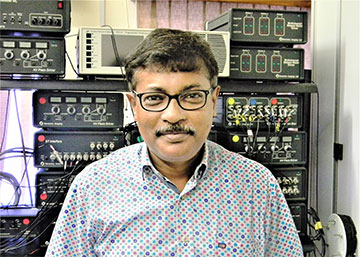
Sandip Dhara
In this installment of Senior Member Insights, OPN talks with Sandip Dhara, the head of the surface and sensors studies division in the materials science group at the Indira Gandhi Centre for Atomic Research (IGCAR), India, and a professor in physical sciences at Homi Bhabha National Institute (HBNI), India.
Dhara is currently interested in nanoscopy using near-field scanning optical microscopy (NSOM) and nanospectroscopy with surface- and tip-enhanced Raman spectroscopy (SERS/TERS). NSOM is used for visualizing surface plasmon polariton waves in degenerate semiconductors and optical materials. Indigenously grown and decorated Au and Ag nanostructure-assisted SERS studies are used for single-molecule detection and chemical sensing. Size-dependent structural and electronic properties in semiconducting nanostructures are studied using TERS.
What first interested you in pursuing science?
I was associated with the science club and many other activities in my secondary-school days. I remember a lecture on “Mathematics of Primary Colors” by one of the senior members of the club, who used to be a researcher in advanced mathematics. The talk inspired me a lot—not only to pursue science, but also to do research in the future.
Interestingly, in India and particularly from my state of Bengal, in those days (the early ‘80s), science was the most nurtured subject among students, irrespective of their interests. I would say that was the social trend among Bengalis.
What aspect of your current work do you find the most interesting or exciting?
Primarily, I am a scientist in one of the R&D laboratories at the Department of Atomic Energy, India, where I lead a team of scientists along with several graduate students registered with them.
I like the academic group meetings the most, where I interact with them to learn about their research problems and often help them to find out the real question behind their problem. The second most interesting thing is to motivate them to achieve challenging goals, which many times are not achieved by others.
“Being part of a network for early-career professionals is essential, as networking can help one get an answer or arrive at a solution.” —Sandip Dhara
What tips for successful networking do you have for early-career professionals?
Being part of a network for early-career professionals is essential, as networking can help one get an answer or arrive at a solution. In this regard, one needs to be part of professional societies. Participation in their activities helps in coming in contact with peers and potential mentors. Attending multidisciplinary seminars and workshops could be another way for early-career professionals to build their network. Lastly, participating in and more importantly being part of organizing conferences are other important avenues.
Successful networking helps with both academic and financial resource generation.
What professional resources do you rely on to stay active and engaged with your field?
While contributing to and keeping abreast of frontier research and developments, monitoring current literature and contributing to the peer review process for journals primarily help me stay active as a scientific professional.
Each year I attend several international conferences and webinars, which keep me professionally updated. Organizing a conference or being a committee member also helps in the long run to establish a network.
What skills do you think are most important for someone interested in a career like yours?
The power of observation is the most important skill to have a successful scientific career. Tools are always there to arrive at a solution, but someone has to find the novelty of a study, which requires keen observational power and analysis. The other important skills are self-motivation and the ability to motivate teammates with effective communication.
“The power of observation is the most important skill to have a successful scientific career.” —Sandip Dhara
What’s the best career decision you’ve ever made, and why?
For some of my career, I used to visit laboratories to meet and make friends worldwide. Later this helped me a lot with finding scientific solutions for many problems and with my professional development. It also helped me promote colleagues and students for their professional development.
What advice do you have for young scientists who are discouraged about their current work or career path?
Perseverance is the only way to achieve the goal. One will always be successful if someone honestly and constantly pursues what one believes.
However, the funding situation may not always be favorable. In that case, if necessary, one has to change one’s laboratory or country. There are plenty of examples of this, even from the recent past.
What is one piece of advice that you wish you were given as a student/early in your career?
I advise young researchers to focus on the present and not to be deterred by future uncertainties. One has to have the self-belief to achieve any dream in life.
What habits do you frequently rely on that help you to succeed?
Take a complete break from research one day a week. Involve yourself with nature, read literature and do anything other than the current research topic. Have a daily workout of 30 minutes—the best workout being a brisk walk.
If you weren’t in the sciences, what would be your dream career?
I would be a painter and photographer.
